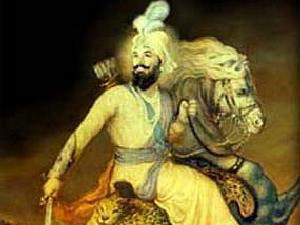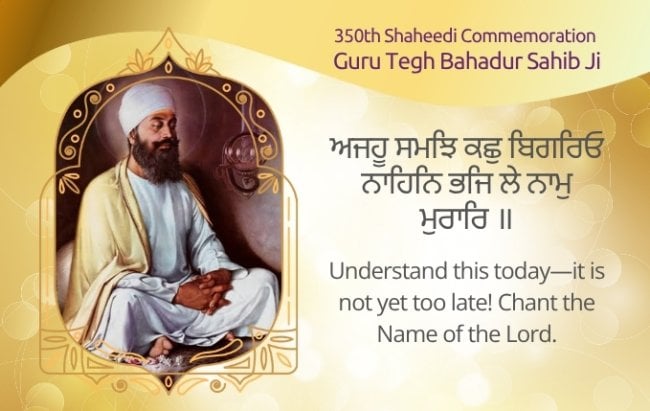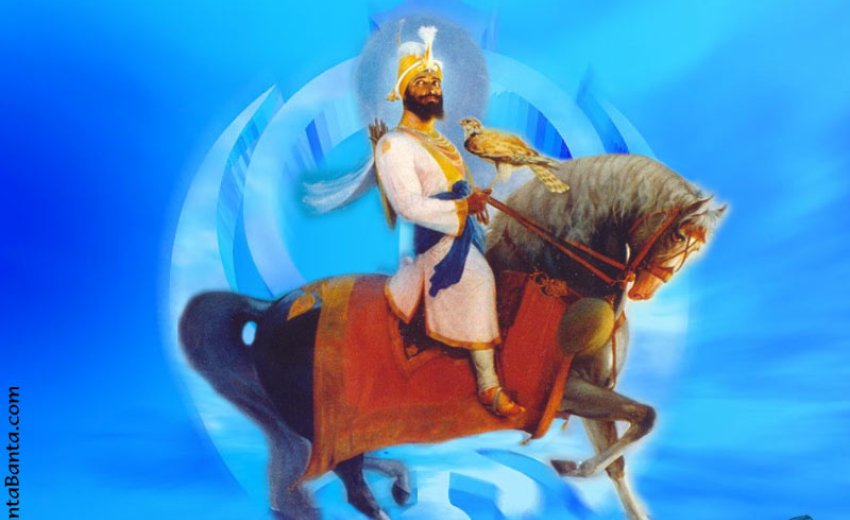 The Prakash Utsav of Sahib-E- Kamaal, Guru Gobind Singh Ji, the Tenth Prophet Guru and the Beau-Ideal of the Sikhs falls in winter, either in late December or in early January. The Sikhs, the world over, will be celebrating with great enthusiasm and they should. The Tenth Nanak carries an extraordinary significance not only for the Khalsa Panth but for the entire people of India. He graced this earth only for a mere short span of two scores and two years. Yet, the morally supreme revolution he brought by his personal sufferings and sacrifices of his father and four sons, indeed, transformed the entire nation of the Indian subcontinent. The hurdles, hurled upon his path every inch of the way, didn’t bog him down. Instead it made him firmly uphold the ideals of righteousness and moral laws for which he was primarily sent to this earth by Akaal Purukh as per his own pre-birth autobiography.
The Prakash Utsav of Sahib-E- Kamaal, Guru Gobind Singh Ji, the Tenth Prophet Guru and the Beau-Ideal of the Sikhs falls in winter, either in late December or in early January. The Sikhs, the world over, will be celebrating with great enthusiasm and they should. The Tenth Nanak carries an extraordinary significance not only for the Khalsa Panth but for the entire people of India. He graced this earth only for a mere short span of two scores and two years. Yet, the morally supreme revolution he brought by his personal sufferings and sacrifices of his father and four sons, indeed, transformed the entire nation of the Indian subcontinent. The hurdles, hurled upon his path every inch of the way, didn’t bog him down. Instead it made him firmly uphold the ideals of righteousness and moral laws for which he was primarily sent to this earth by Akaal Purukh as per his own pre-birth autobiography.
Aurangzeb, the last powerful Mogul Emperor of India, was a contemporary of his father Guru Teg Bahadur and later Guru Ji himself. During his rule, Aurangzeb used extreme degree of torture as a vehicle of coercion to convert the whole Hindustan into Islam. He unleashed a continuous stream of state-sponsored horrible terror upon the majority population of India. He plundered Hindu religious places and the fundamental human rights while denying the freedom to practice religions other than his own.
In order to seek protection from his relentless atrocities, a delegate of Kashmiri Pundits, under the leadership of a Brahmin, Kirpa Ram Mattan, arrived at the court of the ninth Guru of the Sikhs, Guru Teg Bahadur. Upon listening to the details of torture being perpetrated upon Hindus, Guru Teg Bahadur turned contemplative. Once Kirpa Ram Mattan finished his heart rendering story, Guruji mentioned to his son Gobind, barely nine years old then, that in order to thwart such nefarious designs, a spiritual soul willing to sacrifice is needed to stand up to Aurangzeb. The child, Gobind innocently suggested back to his father, “To put a halt to this torture, there couldn’t be a better suitable person than you, my father”! It was a statement of great moral conviction uttered by a child who was born with a divine awareness. The possession of his spiritual wisdom became obvious in the creation of “Khalsa” or ‘the pure ones’ in the year 1699 at Takhat Keshgarh in Anandpur Sahib.
Guru Gobind Singh’s reaffirmation of his commitment to democratic ideals of openness and accountability, so dearly sought in this modern day and age, was very obvious through two letters he wrote to Aurangzeb circa December 1704 i.e. ‘Fatehnamah” and “Zafarnamah’ – the epistles of victory. These letters, written in Persian language truly describe his beliefs about the behavior that a ruler must follow. Very openly and without any fear he wrote to Aurangzeb: “Your name does not become you, Aurangzeb, (broadly translated, Aurangzeb means ‘pride of throne’) since your ways are deceitful”. (1) Further on, he underscored the necessity for the rulers to abide by the same moral principles that they expected from their subjects. “Transparency or openness in actions and integrity of purpose are ethical convictions that must be adhered to, both by the ruler and the ruled”. (2)
Guru Gobind Singh did not hesitate in calling a spade a spade in his writing to Aurangzeb: “He alone is a cultured man, he alone is worthy of being called a human being, whose ‘yes’ is a ‘yes’ and whose ‘no’ means ‘no’. He, who says one thing but means and intends another, is sub-human.” (3). In fact, these letters publicly indict and admonish Emperor for his misdeeds and evil ways. Guru Ji went on further, “You believe neither in God nor the Prophet. You do not keep your words; you lie; you keep your faith in worldly weal and not in God. You know not the value of an oath on the Quran”! (4) A perusal of history hardly offers few instances of a sovereign of a major empire wielding absolute authority being so indicted by the representative of a tiny minority group. (5)
Most rulers depart from this earth after having a mere existence in which they keep their focus primarily on their own needs and comforts. Occasionally, one may come across a tiny fragment that ruled closer to what could be labeled as a morally correct and spiritually uplifting style. In India of yesteryears, especially during the period of Emperor Aurangzeb, the culture, history and religious places of the indigenous majority of India, the Hindus, were frequently trampled by the rulers. He used all available means, including torture and death, to convert the poor, the helpless, the week and the meek into his faith. It was at this point in history when this godly man, Guru Gobind Singh appeared on the Indian scene. To uphold and reaffirm democratic ideals, he first offered resistance through peaceful negotiations to those in power, who were using torture to decimate everything Indian. As a last resort, when all peaceful measures failed, then and only then he opted for the use of unavoidable force through open battles.
In order to protect his birth land and the human rights of its people as well as their faith, he made great personal sacrifices. His entire family including his great-grandfather and his father paid with their lives to preserve the freedom of the people of India so that they could live in tune with their inner voice. Instead of a life of subjugation and for the preservation of a right of religious freedom, his children willingly accepted and courageously kissed painful deaths. When informed about the torture inflicted upon his little children by those arrogant and devious men intoxicated with power, he did not get angry, rather roared like a lion. “What does it matter if my four had to die? There will be crore and crores of my Khalsa Sikhs in future, much closer to me than my own children”. And with this, he instantaneously elevated thousands and thousands of his followers, the Khalsa Sikhs, to the status of his sons and daughters.
And then, submitting to the will of God Almighty at a very desolate moment, he addressed Akaal Purukh as his dear friend in one of the most beautiful pieces of Punjabi Poetry ‘Mitr Piaarai noo, saada haal Mureedaan daa kaina….’.(Go mention to my dear friend God about the state of affairs of its slave disciple….) Where else in the pages of world history could one ever spot the example of a father so graciously accepting sacrifices of all his four children for his people? “It is through such sacrifices that this mortal became immortal, yet, he maintained extreme humility and avoided the trap of a personality cult.
He was a true nationalist of India who paid obedience only to God Almighty, his country and its people. He created a pure and fearless group of followers, from amongst the ordinary downtrodden people of India who had earlier lost hope, courage and their country to the invaders. By creating Khalsa Panth, the camaraderie of Amritdhari Sikhs (also called baptized Sikhs for lack of a better word), Sarbans Daani Guru Ji made sure that his Sikhs will stay uniquely distinct, martial, pure and spiritually supreme. Seeking Amrit for himself from the five beloved-ones whom he had just turned into Khalsa, this man extra-ordinare’ folded his hands and bowed his head in extreme humility setting an example of equality and democratic fraternity. He was Guru yet declared Himself a Chela or disciple and behaved like one to his followers, a true philosophy of democratic ideals never seen before nor will ever be.” Such was the soul and body of Guru Gobind Singh, the God-Guru and disciple all-in-one. He was perhaps one of the rarest examples in the history of world religions, where a spiritual head himself refused to be recognized as God by his followers. Putting a serious injunction against those who ever wished to know him as such, he commanded ‘He who calls me God will for sure burn in the fires of hell, for I am only a servant of God; yea doubt not the veracity of this statement’ (6)
It fills me with great pride to repeat here what has been so eloquently stated by Dr. Gopal Singh; “He abolished privilege and raised the lowest, equal in all ways to the highest and restored to man his manhood, to woman her woman-hood. To him temple and mosques were one and same. Freedom, freedom, freedom resounded from every where, freedom from foreign tyranny as much as from what drags man down: superstition, hypocrisy, ego, self-pity and covetousness, and worst of all, the joyless round of a living death. He only lived for mere two scores and two years but in this short span of life he changed the map of India and world” (7).
“Had this morally correct revolutionary, at the mere age of nine, not accepted his own father’s desire to lay down his life for pursuit of liberty and protection of religious freedom for the people of India, the religious landscape of India would have been entirely different. He encouraged Hindus, to maintain ‘Tilak and Janehoo’- their sacred forehead mark and sacred thread. (8) Through his unparallel sacrifices, Guru Gobind Singh sowed the seeds of religious freedom and democracy so that the people of India could enjoy its fruits for generations to come. He knew that with passage of time, people will collect enough strength to choose and follow their faiths without any fear or favor.
In literature and academia, it was Guru Gobind Singh and Guru Gobind Singh alone who became equally proficient in composing poetry in several languages besides Punjabi, such as Sanskrit, Braj Bhasha, Arabian and Persian, some even not of Indian origin. Writing poetry is one thing but encouraging and supporting a group of fifty two other poets of highest caliber under one roof, is another? At the same time, he saw to it that other fine arts are equally encouraged amongst his followers. The specimen of Gurmukhi Calligraphy written by his expert hands is still preserved on the leaves of some copies of Holy Scriptures of his time as well as inscriptions on several of his Hukumnamas (9). If it were not enough, a special gene for musical skill was equally evident in his mastery of playing Rebeck, Mirdang and Hand-drums (10)
Often times, the religious men of God usually try to ignore their health. For them it is not much of concern as it only relates to the mortal body. Guru Gobind Singh, on the other hand, was not only blessed with an excellent health but he wanted to make it doubly sure that his followers and disciples also maintain their strong physiques. Daily exercises of the muscles and competition in athletic martial arts as well as exercises for the soul for spiritual uplift became one of the greatest passions of this great General of Khalsa. He considered the physical prowess to be as sacred as spiritual sensitiveness, for this was the need of the time (11). A great educationist as he was, he resolved that none of his Sikhs shall remain illiterate, young or old. In fact Guru ji deputed five of his devout Sikhs to Benaras, the then seat of religious learning, to achieve proficiency in Sanskrit and train into ancient Indian literature. (12) It was with them that the tradition of ‘Nirmala Sikhs’ started within Sikh culture.
The historians and writers will always have difficulty in comprehending his extraordinary regal behaviors like owning a blue horse which he always rode while supporting and gracing a white hawk on his left hand and having a plume-decorated turban on his head much like that of a King. To novices, such royal attributes superficially appeared to contradict his above-par godly spiritual qualities. However, he was to combine both these ingredients together to create ‘the Khalsa’, a fraternity of the pure ones with an ingrained unique spirit of ‘Saint-soldier.’ That may be why this King of Kings, Guru Gobind Singh Ji has been glorified by the ordinary mortals as “Mard Agammrah” or “the Man un-fathomable, beyond comprehension. But as he himself mentions in his writing, this was all done in keeping with the ordained ‘Will of God Almighty’ that he was asked to deliver during his sojourn through this earth. He was indeed, the Man supreme, the perfect human being, the Beau-Ideal of Sikh people and indeed, rather, much more.
References:
(I, 2, 3) Patwant Singh: The Sikhs, published by Alfred A. Knopf 2000
(4) Dr. Santokh Singh: published by Spiritual Awakening Studies Canada
(5) Patwant Singh and Jyoti M. Rai: Empire of the Sikhs, 2008, Published by Peter Owen
(6) Bachittar Natak by Guru Gobind Singh as Translated by Dr. Gopal Singh
(7, 8) Dr. Gopal Singh quoted in a pamphlet “Darbar-E-Khalsa 2003
(9) Dr. Harbans Singh: The Heritage of the Sikh.
(10, 11, 12) Dr. Gopal Singh: The History of the Sikh People
Dr. Jaswant Singh Sachdev is the author of a recently published book ‘SQUARE PEGS, ROUND HOLES.’
For information on the book, please contact him.

